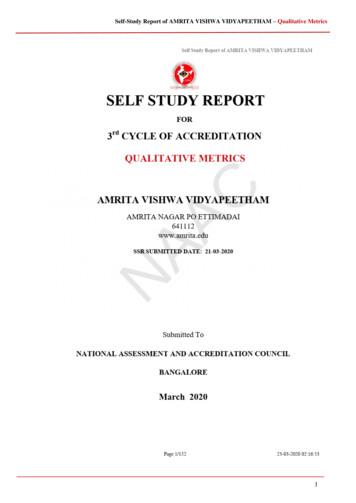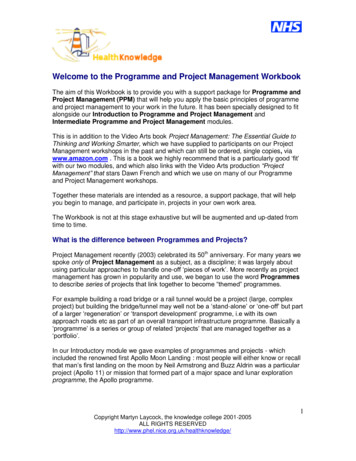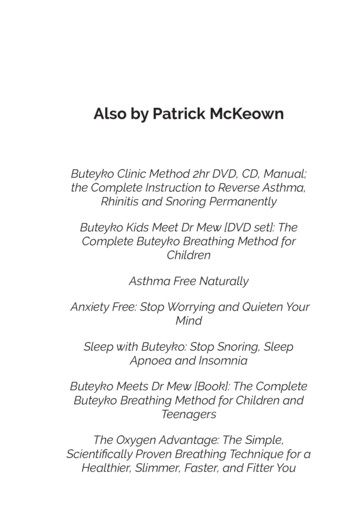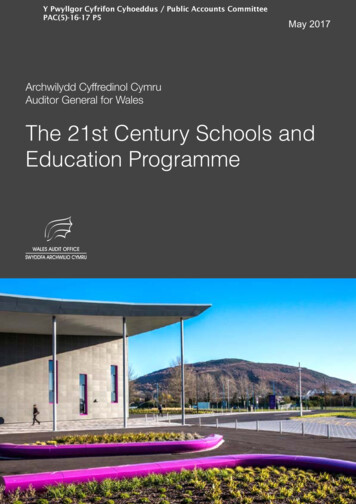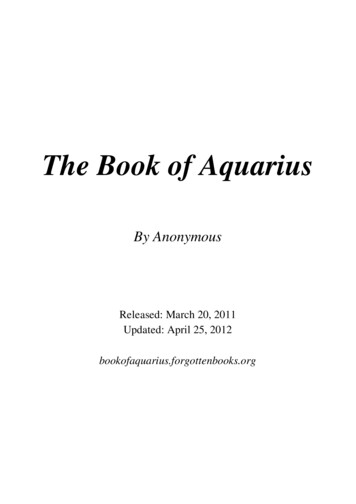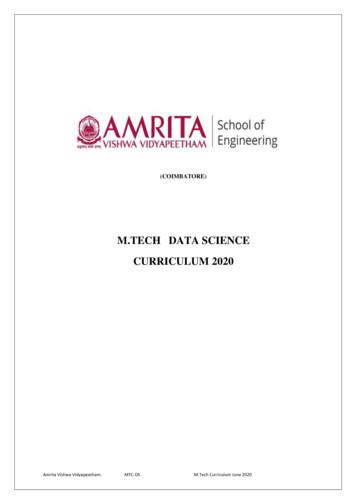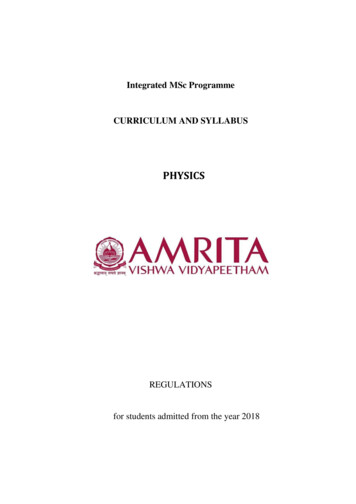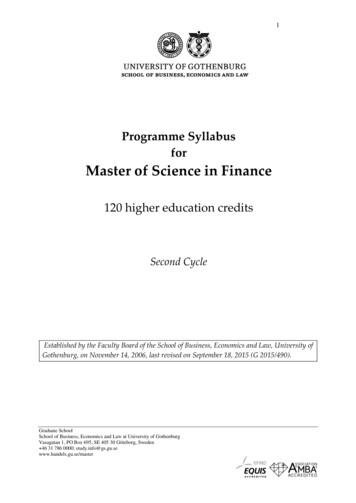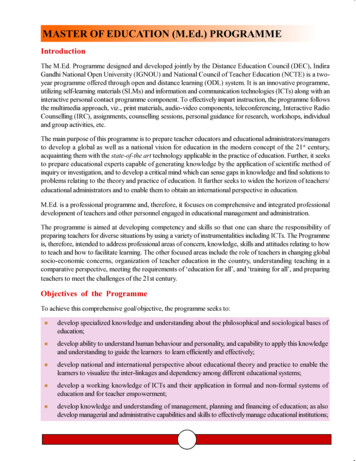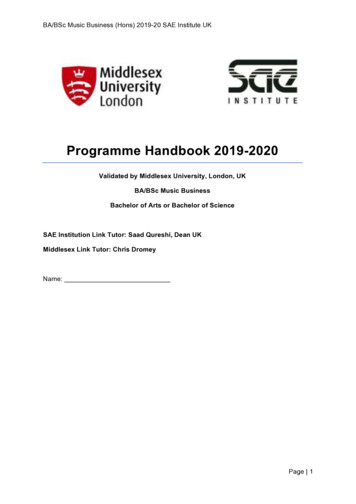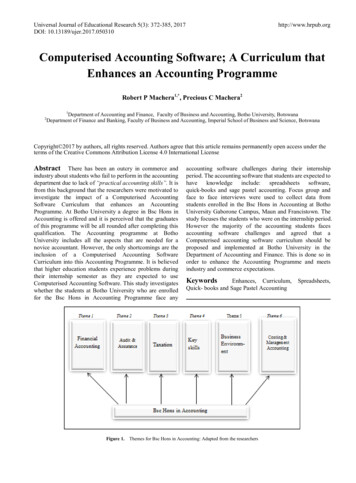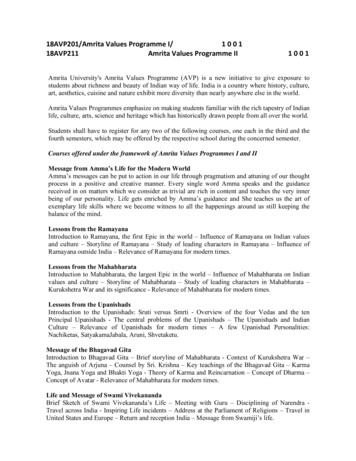
Transcription
18AVP201/Amrita Values Programme I/100118AVP211Amrita Values Programme II1001Amrita University's Amrita Values Programme (AVP) is a new initiative to give exposure tostudents about richness and beauty of Indian way of life. India is a country where history, culture,art, aesthetics, cuisine and nature exhibit more diversity than nearly anywhere else in the world.Amrita Values Programmes emphasize on making students familiar with the rich tapestry of Indianlife, culture, arts, science and heritage which has historically drawn people from all over the world.Students shall have to register for any two of the following courses, one each in the third and thefourth semesters, which may be offered by the respective school during the concerned semester.Courses offered under the framework of Amrita Values Programmes I and IIMessage from Amma’s Life for the Modern WorldAmma’s messages can be put to action in our life through pragmatism and attuning of our thoughtprocess in a positive and creative manner. Every single word Amma speaks and the guidancereceived in on matters which we consider as trivial are rich in content and touches the very innerbeing of our personality. Life gets enriched by Amma’s guidance and She teaches us the art ofexemplary life skills where we become witness to all the happenings around us still keeping thebalance of the mind.Lessons from the RamayanaIntroduction to Ramayana, the first Epic in the world – Influence of Ramayana on Indian valuesand culture – Storyline of Ramayana – Study of leading characters in Ramayana – Influence ofRamayana outside India – Relevance of Ramayana for modern times.Lessons from the MahabharataIntroduction to Mahabharata, the largest Epic in the world – Influence of Mahabharata on Indianvalues and culture – Storyline of Mahabharata – Study of leading characters in Mahabharata –Kurukshetra War and its significance - Relevance of Mahabharata for modern times.Lessons from the UpanishadsIntroduction to the Upanishads: Sruti versus Smrti - Overview of the four Vedas and the tenPrincipal Upanishads - The central problems of the Upanishads – The Upanishads and IndianCulture – Relevance of Upanishads for modern times – A few Upanishad Personalities:Nachiketas, SatyakamaJabala, Aruni, Shvetaketu.Message of the Bhagavad GitaIntroduction to Bhagavad Gita – Brief storyline of Mahabharata - Context of Kurukshetra War –The anguish of Arjuna – Counsel by Sri. Krishna – Key teachings of the Bhagavad Gita – KarmaYoga, Jnana Yoga and Bhakti Yoga - Theory of Karma and Reincarnation – Concept of Dharma –Concept of Avatar - Relevance of Mahabharata for modern times.Life and Message of Swami VivekanandaBrief Sketch of Swami Vivekananda’s Life – Meeting with Guru – Disciplining of Narendra Travel across India - Inspiring Life incidents – Address at the Parliament of Religions – Travel inUnited States and Europe – Return and reception India – Message from Swamiji’s life.
Life and Teachings of Spiritual Masters IndiaSri Rama, Sri Krishna, Sri Buddha, Adi Shankaracharya, Sri Ramakrishna Paramahamsa, SwamiVivekananda, Sri Ramana Maharshi, Mata Amritanandamayi Devi.Insights into Indian Arts and LiteratureThe aim of this course is to present the rich literature and culture of Ancient India and help studentsappreciate their deep influence on Indian Life - Vedic culture, primary source of Indian Culture –Brief introduction and appreciation of a few of the art forms of India - Arts, Music, Dance, Theatre.Yoga and MeditationThe objective of the course is to provide practical training in YOGA ASANAS with a soundtheoretical base and theory classes on selected verses of Patanjali’s Yoga Sutra and Ashtanga Yoga.The coverage also includes the effect of yoga on integrated personality development.Kerala Mural Art and PaintingMural painting is an offshoot of the devotional tradition of Kerala. A mural is any piece of artworkpainted or applied directly on a wall, ceiling or other large permanent surface. In the contemporaryscenario Mural painting is not restricted to the permanent structures and are being done even oncanvas. Kerala mural paintings are the frescos depicting mythology and legends, which are drawnon the walls of temples and churches in South India, principally in Kerala. Ancient temples,churches and places in Kerala, South India, display an abounding tradition of mural paintingsmostly dating back between the 9th to 12th centuries when this form of art enjoyed Royalpatronage. Learning Mural painting through the theory and practice workshop is the objective ofthis course.Course on Organic Farming and SustainabilityOrganic farming is emerging as an important segment of human sustainability and healthy life.Haritamritam’ is an attempt to empower the youth with basic skills in tradition of organic farmingand to revive the culture of growing vegetables that one consumes, without using chemicals andpesticides. Growth of Agriculture through such positive initiatives will go a long way in nationdevelopment. In Amma’s words “it is a big step in restoring the lost harmony of nature“.Benefits of Indian Medicinal SystemsIndian medicinal systems are one of the most ancient in the world. Even today society continues toderive enormous benefits from the wealth of knowledge in Ayurveda of which is recognised as aviable and sustainable medicinal tradition. This course will expose students to the fundamentalprinciples and philosophy of Ayurveda and other Indian medicinal traditions.Traditional Fine Arts of IndiaIndia is home to one of the most diverse Art forms world over. The underlying philosophy ofIndian life is ‘Únity in Diversity” and it has led to the most diverse expressions of culture in India.Most art forms of India are an expression of devotion by the devotee towards the Lord and itsinfluence in Indian life is very pervasive. This course will introduce students to the deeperphilosophical basis of Indian Art forms and attempt to provide a practical demonstration of thecontinuing relevance of the Art.Science of Worship in IndiaIndian mode of worship is unique among the world civilisations. Nowhere in the world has thephilosophical idea of reverence and worshipfulness for everything in this universe found universalacceptance as it in India. Indian religious life even today is a practical demonstration of thepotential for realisation of this profound truth. To see the all-pervading consciousness ineverything, including animate and inanimate, and constituting society to realise this truth can be
seen as the epitome of civilizational excellence. This course will discuss the principles andrationale behind different modes of worship prevalent in India.Temple Mural Arts in KeralaThe traditional percussion ensembles in the Temples of Kerala have enthralled millions over theyears. The splendor of our temples makes art enthusiast spellbound, warmth and grandeur of colorcombination sumptuousness of the outline, crowding of space by divine or heroic figures often within vigorous movement are the characteristics of murals.The mural painting specially area visual counterpart of myth, legend, gods, dirties, and demons ofthe theatrical world, Identical myths are popular the birth of Rama, the story of Bhīma andHanuman, Shiva, as Kirata, and the Jealousy of Uma and ganga the mural painting in Kerala appearto be closely related to, and influenced by this theatrical activity the art historians on temple planes,wood carving and painting the architectural plane of the Kerala temples are built largely on the panIndians almost universal model of the Vasthupurusha.Organic Farming in PracticeOrganic agriculture is the application of a set of cultural, biological, and mechanical practices thatsupport the cycling of farm resources, promote ecological balance, and conserve biodiversity. Theseinclude maintaining and enhancing soil and water quality; conserving wetlands, woodlands, andwildlife; and avoiding use of synthetic fertilizers, sewage sludge, irradiation, and geneticengineering. This factsheet provides an overview of some common farming practices that ensureorganic integrity and operation sustainability.Ayurveda for Lifestyle Modification:Ayurveda aims to integrate and balance the body, mind, and spirit which will ultimately leads tohuman happiness and health. Ayurveda offers methods for finding out early stages of diseases thatare still undetectable by modern medical investigation. Ayurveda understands that health is areflection of when a person is living in harmony with nature and disease arises when a person is outof harmony with the cycles of nature. All things in the universe (both living and nonliving) arejoined together in Ayurveda. This leaflet endow with some practical knowledge to rediscover ourpre- industrial herbal heritage.Life Style and Therapy using YogaYoga therapy is the adaptation of yogic principles, methods, and techniques to specific humanailments. In its ideal application, Yoga therapy is preventive in nature, as is Yoga itself, but it isalso restorative in many instances, palliative in others, and curative in many others. Thetherapeutic effect comes to force when we practice daily and the body starts removing toxins andthe rest is done by nature.Insights into Indian Classical MusicThe course introduces the students into the various terminologies used in Indian musicology andtheir explanations, like Nadam, Sruti, Svaram – svara nomenclature, Stayi, Graha, Nyasa, Amsa,Thala,- Saptatalas and their angas, Shadangas, Vadi, Samavadi, Anuvadi. The course takes thestudents through Carnatic as well as Hindustani classical styles.Insights into Traditional Indian PaintingThe course introduces traditional Indian paintings in the light of ancient Indian wisdom in the fieldsof aesthetics, the Shadanga (Sixs limbs of Indian paintings) and the contextual stories from ancienttexts from where the paintings originated. The course introduces the painting styles such asMadhubani, Kerala Mural, Pahari, Cheriyal, Rajput, Tanjore etc.
Insights into Indian Classical DanceThe course takes the students through the ancient Indian text on aesthetics the Natyasastra and itscommentary the AbhinavaBharati. The course introduces various styles of Indian classical dancesuch as Bharatanatyan, Mohiniyatton, Kuchipudi, Odissy, Katak etc. The course takes the studentsthrough both contextual theory as well as practice time.Indian Martial Arts and Self DefenseThe course introduces the students to the ancient Indian system of self-defense and the combatthrough various martial art forms and focuses more on traditional Kerala’s traditional KalariPayattu.The course introduces the various exercise technique to make the body supple and flexible beforegoing into the steps and techniques of the martial art. The advanced level of this course introducesthe technique of weaponry.Social Awareness CampaignThe course introduces the students into the concept of public social awareness and how to transmitthe messages of social awareness through various media, both traditional and modern. The coursegoes through the theoretical aspects of campaign planning and execution.Temple Mural Arts in KeralaThe traditional percussion ensembles in the Temples of Kerala have enthralled millions over theyears. The splendor of our temples makes art enthusiast spellbound, warmth and grandeur of colorcombination sumptuousness of the outline, crowding of space by divine or heroic figures often within vigorous movement are the characteristics of murals.The mural painting specially area visual counterpart of myth, legend, gods, dirties, and demons ofthe theatrical world, Identical myths are popular the birth of Rama, the story of Bhīma andHanuman, Shiva, as Kirata, and the Jealousy of Uma and ganga the mural painting in Kerala appearto be closely related to, and influenced by this theatrical activity the art historians on temple planes,wood carving and painting the architectural plane of the Kerala temples are built largely on the panIndians almost universal model of the vasthupurusha.Organic Farming in PracticeOrganic agriculture is the application of a set of cultural, biological, and mechanical practices thatsupport the cycling of farm resources, promote ecological balance, and conserve biodiversity. Theseinclude maintaining and enhancing soil and water quality; conserving wetlands, woodlands, andwildlife; and avoiding use of synthetic fertilizers, sewage sludge, irradiation, and geneticengineering. This factsheet provides an overview of some common farming practices that ensureorganic integrity and operation sustainability.Ayurveda for Lifestyle Modification:Ayurveda aims to integrate and balance the body, mind, and spirit which will ultimately leads tohuman happiness and health. Ayurveda offers methods for finding out early stages of diseases that
are still undetectable by modern medical investigation. Ayurveda understands that health is areflection of when a person is living in harmony with nature and disease arises when a person is outof harmony with the cycles of nature. All things in the universe (both living and non-living) arejoined together in Ayurveda. This leaflet endow with some practical knowledge to rediscover ourpre- industrial herbal heritage.Life Style and Therapy using YogaYoga therapy is the adaptation of yogic principles, methods, and techniques to specific humanailments. In its ideal application, Yoga therapy is preventive in nature, as is Yoga itself, but it isalso restorative in many instances, palliative in others, and curative in many others. The therapeuticeffect comes to force when we practice daily and the body starts removing toxins and the rest isdone by nature.
18CUL101 CULTURAL EDUCATION I 2 0 0 2Unit 1Introduction to Indian Culture - Introduction to Amma’s life and Teachings - Symbolsof Indian Culture.Unit 2Science and Technology in Ancient India - Education in Ancient India - Goals of Life– Purusharthas - Introduction to Vedanta and Bhagavad Gita.Unit 3Introduction to Yoga - Nature and Indian Culture - Values from Indian History - Lifeand work of Great Seers of India.TEXTBOOKS:1. The Glory of India (in-house publication)2. The Mother of Sweet Bliss, (Amma’s Life & Teachings)18CUL111 CULTURAL EDUCATION II 2 0 0 2Unit 11. Relevance of Sri Rama and Sri Krishna in this Scientific Age2. Lessons from the Epics of India3. Ramayana & MahabharataUnit 24. Who is a Wise Man?5. A Ruler’s Dharma6. The Story of King ShibiUnit 37. Introduction to the Bhagavad Gita8. Bhagavad Gita – Action without DesireUnit 49. Role and Position of Women in India10. The Awakening of Universal MotherhoodUnit 511. Patanjali’sAstanga - Yoga System for Personality Refinement12. Examples of Heroism and Patriotism in Modern IndiaTEXTBOOKS:Common Resource Material II (in-house publication)Sanatana Dharma - The Eternal Truth (A compilation of Amma’s teachings on Indian Culture)
18ENV300 ENVIRONMENTAL SCIENCE AND SUSTAINABILITY 3 0 0 3Unit 1State of Environment and Unsustainability, Need for Sustainable Development,Traditional conservation systems in India, People in Environment, Need for anattitudinal change and ethics, Need for Environmental Education, Overview ofInternational Treaties and Conventions, Overview of Legal and RegulatoryFrameworks.Environment: Abiotic and biotic factors, Segments of the Environment, BiogeochemicalCycles, Ecosystems (associations, community adaptations, ecological succession,Food webs, Food chain, ecological pyramids), Types of Ecosystems – Terrestrialecosystems, Ecosystem Services, Economic value of ecosystem services, Threatsto ecosystems and conservation strategies.Biodiversity: Species, Genetic & Ecosystem Diversity, Origin of life and significanceof biodiversity, Value of Biodiversity, Biodiversity at Global, National and Local Levels,India as a Mega-Diversity Nation (Hotspots) & Protected Area Network, CommunityBiodiversity Registers. Threats to Biodiversity, Red Data book, Rare, Endangeredand Endemic Species of India. Conservation of Biodiversity. People’s action.Impacts, causes, effects, control measures, international, legal and regulatoryframeworks of: Climate Change, Ozone depletion, Air pollution, Water pollution,Noise pollution, Soil/ land degradation/ pollutionUnit 2Linear vs. cyclical resource management systems, need for systems thinking anddesign of cyclical systems, circular economy, industrial ecology, green technology.Specifically apply these concepts to: Water Resources, Energy Resources, FoodResources, Land & Forests, Waste management.Discuss the interrelation of environmental issues with social issues such as:Population, Illiteracy, Poverty, Gender equality, Class discrimination, Social impacts ofdevelopment on the poor and tribal communities, Conservation movements: people’smovements and activism, Indigenous knowledge systems and traditions of conservation.Unit 3Common goods and public goods, natural capital/ tragedy of commons, Cost benefitanalysis of development projects, Environment Impact Assessment (EIA),Environment Management Plan (EMP), Green business, Eco-labeling, Problems andsolutions with case studies.Global and national state of housing and shelter, Urbanization, Effects of unplanneddevelopment case studies, Impacts of the building and road construction industryon the environment, Eco-homes/ Green buildings, Sustainable communities,Sustainable Cities.Ethical issues related to resource consumption, Intergenerational ethics, Need forinvestigation and resolution of the root cause of unsustainability, Traditional valuesystems of India, Significance of holistic value-based education for true sustainability.TEXTBOOKS/ REFERENCES:1. R. Rajagopalan, Environmental Studies: From Crisis to Cure. Oxford University Press, 2011,358 pages. ISBN: 9780198072089.2. Daniel D. Chiras, Environmental Science. Jones & Bartlett Publishers, 01-Feb-2012, 669
pages. ISBN: 9781449645311.3. Andy Jones, Michel Pimbert and Janice Jiggins, 2011. Virtuous Circles: Values, Systems,Sustainability. IIED and IUCN CEESP, London. URL:http://pubs.iied.org/pdfs/G03177.pdf4. Annenberg Learner, The Habitable Planet, Annenberg Foundation 2015. URL: xtbook.pdf.
APPENDIX 7AMRITA VISHWA VIDYAPEETHAMArts & Sciences Undergraduate ProgrammesFirst Semester (2018 admission onwards)18ENG101Communicative English2-0-2-3Objectives:To help students obtain an ability to communicate fluently in English; to enable and enhancethe students skills in reading, writing, listening and speaking; to impart an aesthetic sense andenhance creativityCourse Contents:Unit IKinds of sentences, usage of preposition, use of adjectives, adverbs for description, Tenses,Determiners- Agreement (Subject – Verb, Pronoun- Antecedent) collocation, Phrasal Verbs,Modifiers, Linkers/ Discourse Markers, Question TagsUnit IIParagraph writing – Cohesion - Development: definition, comparison, classification, contrast, causeand effect - Essay writing: Descriptive and NarrativeUnit IIILetter Writing - Personal (congratulation, invitation, felicitation, gratitude, condolence etc.) Official(Principal / Head of the department/ College authorities, Bank Manager, Editors of newspapers andmagazines)Unit IVReading Comprehension – Skimming and scanning- inference and deduction – Reading differentkinds of material –Speaking: Narration of incidents / stories/ anecdotes- Current News AwarenessUnit VProse: John Halt’s ‘Three Kinds of Discipline’ [Detailed]Max Beerbohm’s ‘The Golden Drugget’ [Detailed]Poems: Ogden Nash- ‘This is Going to Hurt Just a Little Bit’ [Detailed]Robert Kroetsch– ‘I am Getting Old Now’, Langston Hughes- ‘I, Too’ [Detailed]Wole Soyinka- ‘Telephone Conversation’ [Non- Detailed]Kamala Das- ‘The Dance of the Eunuchs’ [Non-Detailed]Short Stories: Edgar Allan Poe’s ‘The Black Cat’, Ruskin Bond’s ‘The Time Stops at Shamili’ [NonDetailed]CORE READING:1. Ruskin Bond, Time Stops at Shamli and Other Stories, Penguin Books India Pvt Ltd, 19892. Syamala, V. Speak English in Four Easy Steps, Improve English Foundation Trivandrum: 20063. Beerbohm, Max, The Prince of Minor Writers: The Selected Essays of Max Beerbohm (NYRBClassics), Phillip Lopate (Introduction, Editor), The New York Review of Book Publishers.4. Edger Allan Poe. The Selected Works of Edger Allan Poe. A Running Press, 2014.5. Online sources
References:6. Ruskin Bond, Time Stops at Shamli and Other Stories, Penguin Books India Pvt Ltd, 19897. Martinet, Thomson, A Practical English Grammar, IV Ed. OUP, 1986.8. Murphy, Raymond, Murphy’s English Grammar, CUP, 20049. Online sourcesAMRITA VISHWA VIDYAPEETHAMArts & Sciences Undergraduate ProgrammesSecond Semester (2018 admission onwards)18ENG121Professional Communication1- 0-2-2Objectives:To convey and document information in a formal environment; to acquire the skill of selfprojection in professional circles; to inculcate critical and analytical thinking.Unit IVocabulary Building: Prefixes and Suffixes; One word substitutes, Modal auxiliaries,Error Analysis:Position of Adverbs, Redundancy, misplaced modifiers, Dangling modifiers – Reported SpeechUnit IIInstruction, Suggestion & Recommendation - Sounds of English: Stress, Intonation- Essay writing: Analytical and ArgumentativeUnit IIICirculars, Memos – Business Letters - e - mailsUnit IVReports: Trip report, incident report, event report - Situational Dialogue - Group DiscussionUnit VListening and Reading Practice - Book ReviewReferences1. FelixaEskey. Tech Talk, University of Michigan. 20052. Michael Swan. Practical English Usage, Oxford University Press. 20053. Anderson, Paul. Technical Communication: A Reader Centered Approach, V Edition, Hercourt,2003.4. Raymond V. Lesikar and Marie E. Flatley. Basic Business Communication, Tata Mc GrawHill Pub. Co. New Delhi. 2005. Tenth Edition.5. Thampi, G. Balamohan. Meeting the World: Writings on Contemporary Issues. Pearson, 2013.6. Lynch, Tony. Study Listening. New Delhi: CUP, 2008.7. Kenneth, Anderson, Tony Lynch, Joan Mac Lean. Study Speaking. New Delhi: CUP, 2008.8. Marks, Jonathan. English Pronunciation in Use. New Delhi: CUP, 2007.9. Syamala, V. Effective English Communication For You (Functional Grammar, Oral and WrittenCommunication): Emerald, 2002.
AMRITA VISHWA VIDYAPEETHAMBBM/BCA/ Int.MA/Int. Msc/B.Com/BA/B.Sc (VM)First Semester18HIN101HINDI I1-0-2[2cr]Unit-1a)Introduction to Hindi Language, -other Indian Language’s, Official Language, linkLanguage Technical terminology.b) Hindi alphabet: ParibhashaAurBhed.c) Shabda: ParibhashaAurBhed, RoopantharkiDrishti sed) Sangya -ParibhashaAurBhed,SangyakeRoopanthar-ling, vachan, karake) Sarvanaam- ParibhashaAurBhed.Unit-2a) Common errors and error corrections in Parts of Speech –with emphasis on use ofpronouns, Adjective and verb in different tenses –gender& numberb) Conversations, Interviews, Short speeches.Unit -3a) Letter writing –ParibhashaAurBhed, Avedanpatra (request letter) & Practiceb) Translation-ParibhashaAurBhed, English to HindiUnit- 4Peom :a) Maithilisharangupth: sakhivemujsekahakarjaateb) Suryakanthtripatinirala :Priyatamc) Mahadevivarma- adhikaard) Shiyaramsharangupth:ekphoolkichahUnit- 5Kahania) Kafan - Premchand ,b) Rajasthan ki Ek Gaav kee theerthyatra - Beeshmasahnic) Raychandrabhai :By Mahathma Gandhi - Sathya ke prayogd) Rajani - Mannu Bhandari
AMRITA VISHWA VIDYAPEETHAMBBM/BCA/ Int.MA/Int. Msc /B.Com/BA/B.Sc (VM)Second Semester18HIN111HINDI II1-0-2[2cr]Unit -1a) Visheshan- ParibhashaAurBhed.special usage of adverbs, changing voice andconjunctions in sentences.b) kriya- ParibhashaAurBhed, rupantharkidrushti se-kaalc) padhparichay.d) Vigyapan Lekhan (Advertisement writing), Saar Lekhan (Precise writing).Unit -2Communicative Hindi – MoukhikAbhivyakthi –understanding proper pronunciation, Haptics etc in Interviews ,short speeches .Unit -3Film review,Audio –Visual-Media in Hindi – Movies appreciation and evaluation.News readingand presentations in Radio and Tv channels in Hindi, samvaadhlekhan,Unit -4a) Harishankarparasaiyi- SadacharkaThavisb) Jayashankarprasadh – Mamatac) Mannubandari- Akelid) Habibtanvir- KarthusUnit -5Kavya Taranga) Himadri thung shrung se (poet- Jayasankar prasad)b) Dhabba (poet- kedarnath sing) ,c) Proxy (poet- Venugopal),d) Machis(poet –Suneeta Jain) ,e) Vakth. (poet – Arun kamal)f) Fasal (poet- Sarveshwar Dayal Saxena)
AMRITA VISHWA VIDYAPEETHAMKANNADA SYLLABUS(From 2018 onwards – All UG)Semester – I18KAN101 KANNADA I1-0-2[2cr]To enable the students to acquire basic skills in functional language.To develop independent reading skills and reading for appreciating literary works.To analyse language in context to gain an understanding of vocabulary, spelling,punctuation and speechUNIT – 1 Railway Nildanadalli – K. S. Narasimha SwamyAmma, Aachara Mattu Naanu – K. S. Nisar AhamadKerege Haara – JanapadaSimhaavalokana – H.S. ShivaprakashUNIT – 2 Dhanwantri Chikitse - Kuvempu Mouni - Sethuram Meenakshi Maneya Mestru - KuvempuUNIT – 3 Sukha –H.G Sannaguddayya Mobile Thenkara Jen Nonagala Jhenkara – Nagesh Hegade Namma Yemmege Maatu Tiliyitu – Goruru Ramaswamy IyangarUNIT – 4Language structure Usage of punctuation marks Introduction to words (right usage) Reading skills Sentence formation (simple & complex) Translation- English to KannadaReferences:1.2.3.4.Kannada Samskruti Kosha – Dr. Chi. C LingannaKannada Sanna Kathegalu – G H NayakLekhana Kale – N. Prahlad RaoKannada Sahithya Charithre – R. Sri Mugali
AMRITA VISHWA VIDYAPEETHAMKANNADA SYLLABUS(From 2018 onwards – All UG)Semester – II18KAN111KANNADA II1-0-2[2cr]Objectives: To enable the students to acquire basic skills in functional language. To develop independent reading skills and reading for appreciating literary works. To develop functional and creative skills in language. To enable the students to plan, draft, edit & present a piece of writing.UNIT – 1 Bettada Melondu Maneya Maadi – Akka MahadeviThallanisadiru Kandya – KanakadasaAvva – P. LankeshNeevallave – K. S. Narasimha SwamyUNIT – 2Gunamukha – Drama by P. LankeshUNIT – 3Karvalo – Novel by Poornachandra ThejaswiUNIT – 4Letter Writing –Personal (congratulation, invitation, condolence etc.) Official (To Principal, Officials of various departments, etc.,) Report writing Essay writing Precise writingPrescribed text:1. Gunamukha by P. Lankesh (Lankesh Prakashana)2. Karvalo by Poornachandra Thejaswi (Mehtha publishing house)Reference1. Saamanyanige Sahithya Charitre (chapter 1 to 10) – Bangalore UniversityPublication2. Hosa Kannada Saahithya Charithre – L.S Sheshagiri Rao3. Kacheri Kaipidi – Kannada Adhyayana Samsthe (Mysuru University)
4. Kannada Sahithya Charithre – R. Sri Mugali5. H.S.Krishna Swami Iyangar – Adalitha Kannada – Chetana Publication, Mysuru
18SSK201LIFE SKILLS I1022Soft skills and its importance: Pleasure and pains of transition from an academic environment towork-environment. Need for change. Fears, stress and competition in the professional world.Importance of positive attitude, self-motivation and continuous knowledge upgradation.Self Confidence: Characteristics of the person perceived, characteristics of the situation,Characteristics of the Perceiver. Attitude, Values, Motivation, Emotion Management, Steps tolike yourself, Positive Mental Attitude, Assertiveness.Presentations: Preparations, Outlining, Hints for efficient practice, Last minute tasks, means ofeffective presentation, language, Gestures, Posture, Facial expressions, Professional attire.Vocabulary building: A brief introduction into the methods and practices of learning vocabulary.Learning how to face questions on antonyms, synonyms, spelling error, analogy etc. Faultycomparison, wrong form of words and confused words like understanding the nuances ofspelling changes and wrong use of words.Listening Skills: The importance of listening in communication and how to listen actively.Prepositions and Articles: A experiential method of learning the uses of articles and prepositionsin sentences is provided.Problem solving; Number System; LCM &HCF; Divisibility Test; Surds and Indices;Logarithms; Ratio, Proportions and Variations; Partnership; Time speed and distance; work timeproblems;Data Interpretation: Numerical Data Tables; Line Graphs; Bar Charts and Pie charts; CaseletForms; Mix Diagrams; Geometrical Diagrams and other forms of Data Representation.Logical Reasoning: Family Tree; Linear Arrangements; Circular and Complex Arrangement;Conditionalities and Grouping; Sequencing and Scheduling; Selections; Networks; Codes;Cubes; Venn Diagram in Logical Reasoning.TEXTBOOKS:1.A Communicative Grammar of English: Geoffrey Leech and Jan Svartvik. Longman,London.2.Adair J (1986) - "Effective Team Building: How to make a winning team", London, U.K:Pan Books.3.Gulati S (2006) - "Corporate Soft Skills", New Delhi, India: Rupa& Co.4.The Hard Truth about Soft Skills, by Amazone Publication.REFERENCES:1.Quantitative Aptitude, by R S Aggarwal, S Chand Publ.2.Verbal and Non-verbal Reasoning, R S Aggarwal, S Chand Publ.3.Data Interpretation, R S Aggarwal, S Chand Publ.4.Nova GRE, KAPAL GRE, Barrons GRE books;
5.6.7.8.9.10.Quantitative Aptitude, The Institute of Chartered Accountants of India.More Games Teams Play, by Leslie Bendaly, McGraw-Hill Ryerson.The BBC and British Council online resourcesOwl Purdue University online teaching resourceswww.thegrammarbook.com online teaching resourceswww.englishpage.com online teaching resources and other useful websites.18SSK211LIFE SKILLS II1022Professional Grooming and Practices: Basics of Corporate culture, Key pillars of BusinessEtiquette. Basics of Etiquette: Etiquette – Socially acceptable ways of behaviour, Personalhygiene, Professional attire, Cultural Adaptability. Introductions and Greetings: Rules of thehandshake, Earning respect, Business manners. Telephone Etiquette: activities during theconversation, Conclude the call, To take a message. Body Language: Components, U
Lessons from the Upanishads Introduction to the Upanishads: Sruti versus Smrti - Overview of the four Vedas and the ten Principal Upanishads - The central problems of the Upanishads - The Upanishads and Indian Culture - Relevance of Upanishads for modern times - A few Upanishad Personalities: Nachiketas, SatyakamaJabala, Aruni, Shvetaketu.
